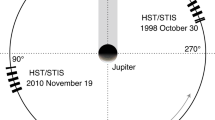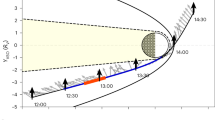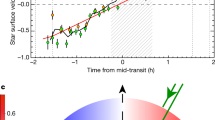Abstract
THE magnetosphere in the vicinity of the orbits of Saturn's icy satellites consists of a low-density plasma, in which the electrons are an order of magnitude cooler than the accompanying heavy ions1. Most models2–12 neglect this fact, even though radiative cooling and diffusive loss rates are both too slow to account for the observed temperatures. Shemansky and Hall13 have recently proposed that the electrons could be cooled by the presence of a large abundance of neutral gas, derived mainly from the breakdown products of H2O (mainly O and OH) from the icy satellites. Hydrogen radicals have been reported in this region13, but these originate from the atmosphere of Saturn itself; no satellite-derived neutral species have been detected. Here we report the detection of neutral OH molecules near the orbit of Tethys, using the Faint Object Spectrograph on the Hubble Space Telescope. Our results suggest that neutral OH is one of the dominant species in Saturn's inner magnetosphere, implying a source rate for H2O twenty times greater than current theoretical estimates5,6. One possible explanation is that the micrometeorite erosion rates of the inner satellites are significantly higher than expected.
This is a preview of subscription content, access via your institution
Access options
Subscribe to this journal
Receive 51 print issues and online access
$199.00 per year
only $3.90 per issue
Buy this article
- Purchase on Springer Link
- Instant access to full article PDF
Prices may be subject to local taxes which are calculated during checkout
Similar content being viewed by others
References
Richardson, J. D. & Sittler, E. C. J. geophys. Res. 95, 12019–12031 (1990).
Ip, W. H. Astrophys. J. 246, 344–353 (1981).
Sieveka, E. M. & Johnson, R. E. Icarus, 51, 528–548 (1982).
Eviatar, A. J. geophys. Res. 89, 3821–3828 (1984).
Johnson, R. E. et al. Icarus 77, 311–329 (1989).
Pospieszalska, M. K. & Johnson, R. E. Icarus 93, 45–52 (1991).
Richardson, J. D., Eviatar, A. & Siscoe, G. L. J. geophys. Res. 91, 8749–8755 (1986).
Richardson, J. D. & Eviatar, A. Geophys. Res. Lett. 14, 999–1002 (1987).
Richardson, J. D. & Eviatar, A. J. geophys Res. 93, 7297–7306 (1988).
Barbosa, D. D. J. geophys. Res. 95, 17167–17177 (1990).
Eviatar, A. & Richardson, J. D. Ann. geophys. 8, 725–732 (1990).
Richardson, J. D. J. geophys. Res. 97, 13705–13713 (1992).
Shemansky, D. E. & Hall, D. T. J. geophys. Res. 97, 4143–4161 (1992).
Kurucz, R. L., Furenlid, I., Brault, J. & Testerman, L. Solar Flux Atas for 296 to 1300 nm (Harvard Univ. Press, 1984).
Schleicher, D. G. & A'Hearn, M. F. Astrophys. J. 331, 1058–1077 (1988).
Weiser, H., Vitz, R. C. & Moos, H. W. Science 197, 755–757 (1977).
Broadfoot, A. L. et al. Science 212, 206–211 (1981).
Hilton, D. A. & Hunten, D. M. Icarus 73, 248–268 (1988).
Eviatar A. & Richardson, J. D. Ann. geophys. 10, 511–518 (1992).
Shemansky, D. E. J. geophys. Res. 93, 1773–1784 (1988).
Bagenal, F., Shemansky, D. E., McNutt, R. L. Jr, Schreier, R. & Eviatar, A. Geophys. Res. Lett. 19, 79–82 (1992).
Author information
Authors and Affiliations
Rights and permissions
About this article
Cite this article
Shemansky, D., Matheson, P., Hall, D. et al. Detection of the hydroxyl radical in the Saturn magnetosphere. Nature 363, 329–331 (1993). https://doi.org/10.1038/363329a0
Received:
Accepted:
Issue Date:
DOI: https://doi.org/10.1038/363329a0
This article is cited by
-
JWST molecular mapping and characterization of Enceladus’ water plume feeding its torus
Nature Astronomy (2023)
-
Higher harmonics electrostatic ion cyclotron parallel flow velocity shear instability with inhomogeneous DC electric field in the magnetosphere of Saturn
Astrophysics and Space Science (2018)
-
Saturn Plasma Sources and Associated Transport Processes
Space Science Reviews (2015)
-
Extreme Ultraviolet Radiation Measurement for Planetary Atmospheres/Magnetospheres from the Earth-Orbiting Spacecraft (Extreme Ultraviolet Spectroscope for Exospheric Dynamics: EXCEED)
Space Science Reviews (2014)
-
Ultraviolet emissions in the planetary atmospheres
Astrophysics and Space Science (2011)
Comments
By submitting a comment you agree to abide by our Terms and Community Guidelines. If you find something abusive or that does not comply with our terms or guidelines please flag it as inappropriate.



